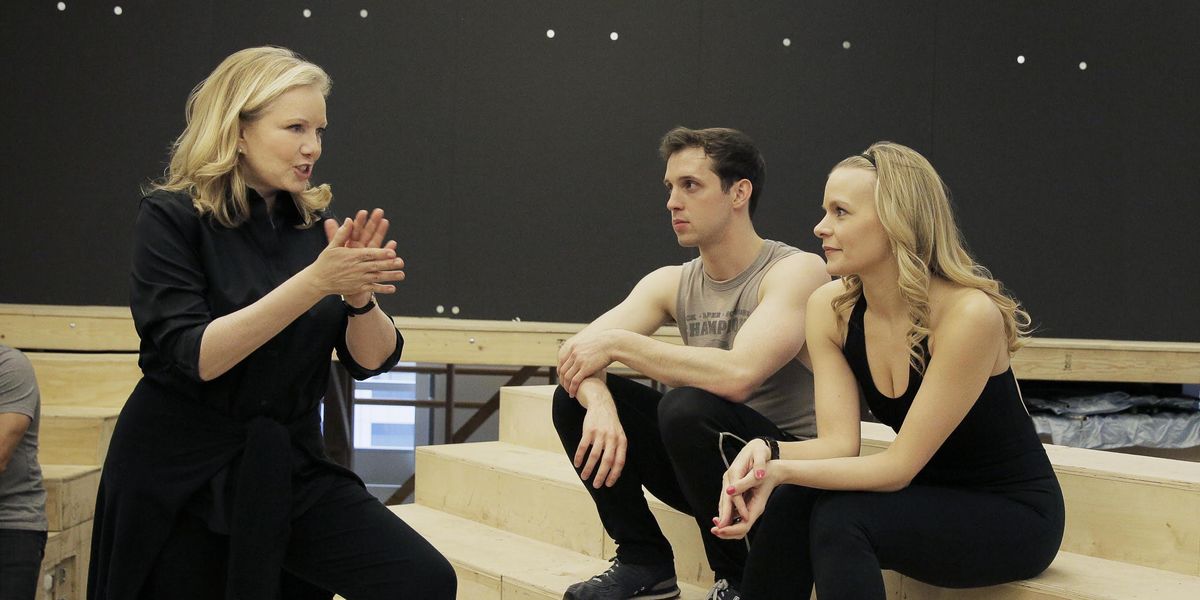What Does It Take to Become a Broadway Choreographer?
In much of the dance world, the process of becoming successful as a choreographer can seem frustratingly oblique. On Broadway, however, that path is surprisingly linear and well defined. Most people end up following a sequence of positions that includes becoming dance captain of a show, then assistant choreographer, then associate choreographer and, finally, main choreographer. What boosts you from one rung of the ladder to the next is a combination of initiative, networking and, of course, creativity.
Climb the Ladder
Before getting hired to choreograph a Broadway show, artists typically follow a clear career trajectory, and end up with these three credits on their resumé:
Dance captain:
Performs in the show and also serves as the keeper of the choreography. “They get all their information from the associate choreographer—charts, notes, when to give notes, how to maintain the show,” says Stephanie Klemons, associate choreographer for In the Heights and Hamilton. According to Susan Stroman, who’s choreographed and directed Broadway hits like The Producers and Young Frankenstein it’s a great starting place because you see both sides of the Broadway coin: “You work not only with the creatives but also with management, scheduling and teaching understudies.”
Assistant choreographer:
Might occasionally function in an administrative capacity—taking notes, for instance—but can also be someone for the main choreographer to bounce ideas off of.
Associate choreographer:
Has a deeper level of collaboration and can even create choreography themselves when needed, says Klemons. Both the associate and assistant choreographers’ jobs officially end on opening night, but the associate often maintains a production later on. “If there’s a tour, the associate might remount it,” says Stroman.

Stephanie Klemons speaking to the cast of Hamilton
Oliver Wheeldon, Courtesy Klemons
Make Yourself Indispensable
A big part of the Broadway-choreography-success pie is getting rehired. Whether you’re an assistant or associate, a surefire way to do that is by learning to anticipate the needs of the choreographer you’re working with.
Be a collaborative partner.
Knowing when to offer your opinion and when to stay silent can be tricky, says Ellenore Scott, associate choreographer for King Kong. “You’re a vehicle for the choreographer to figure out their ideas,” says Scott, “so you need to know when to make suggestions, when to support ideas, when to provide options and when not to speak.”
Be organized.
A dependable assistant, says Klemons, keeps track of notes and movement sequences that might be temporarily tabled—even phrases that a choreographer might improvise on the side during a break.
Be a sympathetic middle man.
“You are the liaison between what the choreographer is saying and what the dancers are hearing,” says Scott. Sometimes that means serving as a sounding board. “You might go to the cast and say, ‘If you’re angry at Mom and Dad right now—the choreographer and the director—I’m someone you can vent to,’ ” she says. It’s another balancing act: “You need to support your choreographer but also keep the dancers informed and happy.”
Be bold with big personalities.
“Sometimes you need someone who’s good at wrangling eccentric personalities,” says Stroman. “If you know you’re heading into a show that has that, you want an associate who’s not going to be afraid and can handle it.”
Be a ready and willing body.
“I’ll ask my assistant, ‘Can you do that kick 700 times, so I can figure out how that part ends?’ ” says Klemons.
Be prepared to network.
It takes many people to develop a production. “Make connections with everyone,” says Scott. “Genuinely get to know people and find out what their processes are like. I’ve gotten job opportunities from the props master!”
From Associate to Head Choreographer
Making the leap from associate to main choreographer is often equal parts persistence, a good reputation and saying yes to unexpected projects. For Klemons, it was a series of incremental steps—choreographing five new numbers on Zelda, a show where Andy Blankenbuehler technically served as main choreographer; creating and setting Bring It On‘s Macy’s Thanksgiving Day Parade performance; and choreographing a 2018 Super Bowl commercial after an Instagram follower contacted her agents. She’s now choreographing regional productions and new works.
What to Do During the Pandemic
With Broadway on hold, the outlook for would-be choreographers might seem grim. But there are still productive ways to develop your skills. “Take other choreographers’ virtual workshops,” says Scott. This is also an opportunity to devote time to figuring out what your style is. “What’s your choreographic voice? It needs to be something unique, something that producers see and think, Yes, this show needs this,” says Scott.
Klemons has spent her time on Zoom with creative teams. “I have to create musicals, to create moments, so that when we get on the other side of this apocalypse, I will have something to pitch to a producer.”
Most importantly, don’t throw in the towel. “Yes, you’re coming up at one of the hardest times, but that’s going to leave you with a tattoo,” says Klemons. “It’s going to make you special, that you could live and create through this.”
Be in the Room Where It Happens
The Stage Directors and Choreographers Foundation offers an apprenticeship opportunity called the Observership Program, in which early- and midcareer choreographers get to work with master choreographers. “On every show I’ve done for the last 30 years, I’ve hired an observer to watch and ultimately participate in some way, whether they’re taking notes for me or drilling a step with someone in the corner,” says Stroman. Participants receive both a weekly and a travel stipend. Choreographic mentors for the 2019–20 season included Camille A. Brown, Sam Pinkleton and Raja Feather Kelly.




